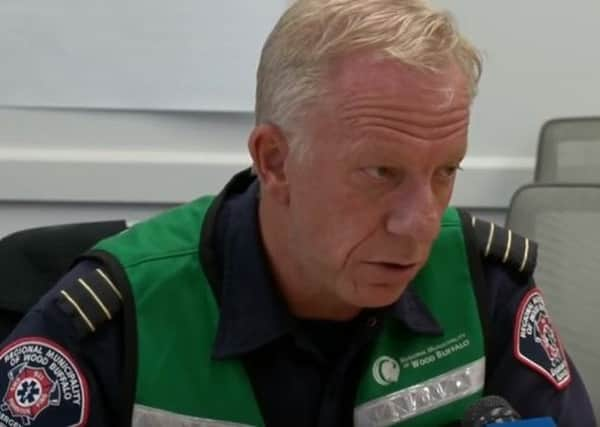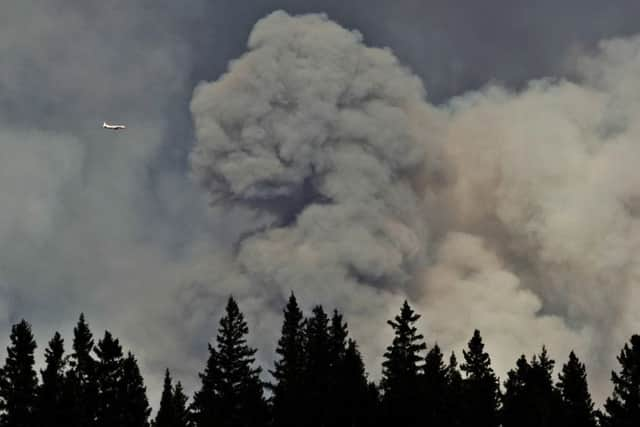Former Portsmouth firefighter hailed a hero after Canadian wildfire mass evacuation


Darby Allen led the operation to get 88,000 people to safety as blazes swept through Fort McMurray in Alberta.
Everyone escaped without injury and there has been widespread praise for Mr Allen, who was a Portsmouth firefighter for six years before emigrating to Canada in 1990.
Advertisement
Hide AdAdvertisement
Hide AdHe joined Calgary Fire Department and rose through the ranks to become regional chief for Wood Buffalo in 2011.


Canadian radio host Charles Adler tweeted yesterday: “On behalf of a grateful nation, thank you Darby Allen, #FtMcMurray fire chief, for exceptional leadership”.
And Hampshire Fire and Rescue Service group manager Jason Avery said: “Our thoughts on #IFFD (International Firefighter Day) are with chief Darby Allen, ex-Hampshire firefighter now tackling the fire of his career”.
An emotional Mr Allen told a press conference: “We successfully evacuated 88,000 people.
“No one is hurt and no one is passed away right now.


Advertisement
Hide AdAdvertisement
Hide Ad“I really hope we get to the end of this and we can still say that.
“We are here, we are strong and we will keep doing our job.”
The Alberta government, which has declared a state of emergency, said more than 1,100 firefighters, 145 helicopters, 138 pieces of heavy equipment and 22 air tankers were fighting 49 wildfires, with seven considered out of control.
Chad Morrison of AB Wildfire, manager of wildfire prevention, said the fire is still growing but is moving away from Fort McMurray and its rate of growth has slowed.
Advertisement
Hide AdAdvertisement
Hide AdAbout 25,000 evacuees moved north in the hours after Tuesday’s mandatory evacuation, where oil sands work camps were converted to house people. But the bulk of the more than 80,000 evacuees fled south to Edmonton and elsewhere, and officials are moving everyone south where they aim to have better support for the displaced.
Officials had flown 4,000 evacuees to Edmonton and Calgary by Thursday evening and expected to fly 4,000 more by the end of the day. They hope the highway will become safe enough on Friday to move the remaining people out via the south. A helicopter will lead the evacuation convoy to make sure the highway is safe, and will pass through Fort McMurray where the fire has destroyed 1,600 homes and other buildings.
Alberta premier Rachel Notley said the first convoy will be 400 vehicles and officials will see how that goes.
There have been no injuries or deaths in the province from the fires, and Ms Notley said financial support will be provided to Albertans and cash cards may be made available for evacuated residents.
Advertisement
Hide AdAdvertisement
Hide AdThe Alberta government has declared a province-wide fire ban in an effort to reduce the risk of more blazes in a region that is very hot and dry.
“It is a very rare step,” environment minister Shannon Phillips said. She added that ignoring the ban could lead to fines.
Fort McMurray is surrounded by wilderness and is Canada’s main oil sands town. Despite the size of the town and its importance to the Canadian economy, there are essentially only two ways out by car. The region has the third largest reserves of oil in the world behind Saudi Arabia and Venezuela.
Aided by high winds, scorching heat and low humidity, the fire grew from 75 square kilometres on Tuesday to 100 square kilometres on Wednesday, but by Thursday it was almost nine times that - at 850 square kilometres.
Advertisement
Hide AdAdvertisement
Hide AdThe fire remained wrapped around the western and southern edges of the city. No rain clouds are expected around Fort McMurray until late on Saturday, with 40% chance of showers, according to online forecasts by Environment Canada.
Unseasonably hot temperatures combined with dry conditions have transformed the boreal forest in much of Alberta into a tinder box. Mr Morrison said officials are investigating the cause of the fire but he said it started in a remote forested area and could have been lightning.
A combination of factors conspired to make this wildfire especially ferocious, said Bill Patzert, a climatologist at Nasa’s Jet Propulsion Laboratory in California. The El Nino global weather system brought Alberta a mild winter and low snowpack, he said. Mr Patzert said the flames sparked at a time between the snowy season and before springtime rains that turn the landscape green, making the region especially vulnerable to wildfire.
“In a way, it’s a perfect storm. It’s been warm, it’s been dry and windy. It’s the in-between period before you’re in the full bloom of spring.”